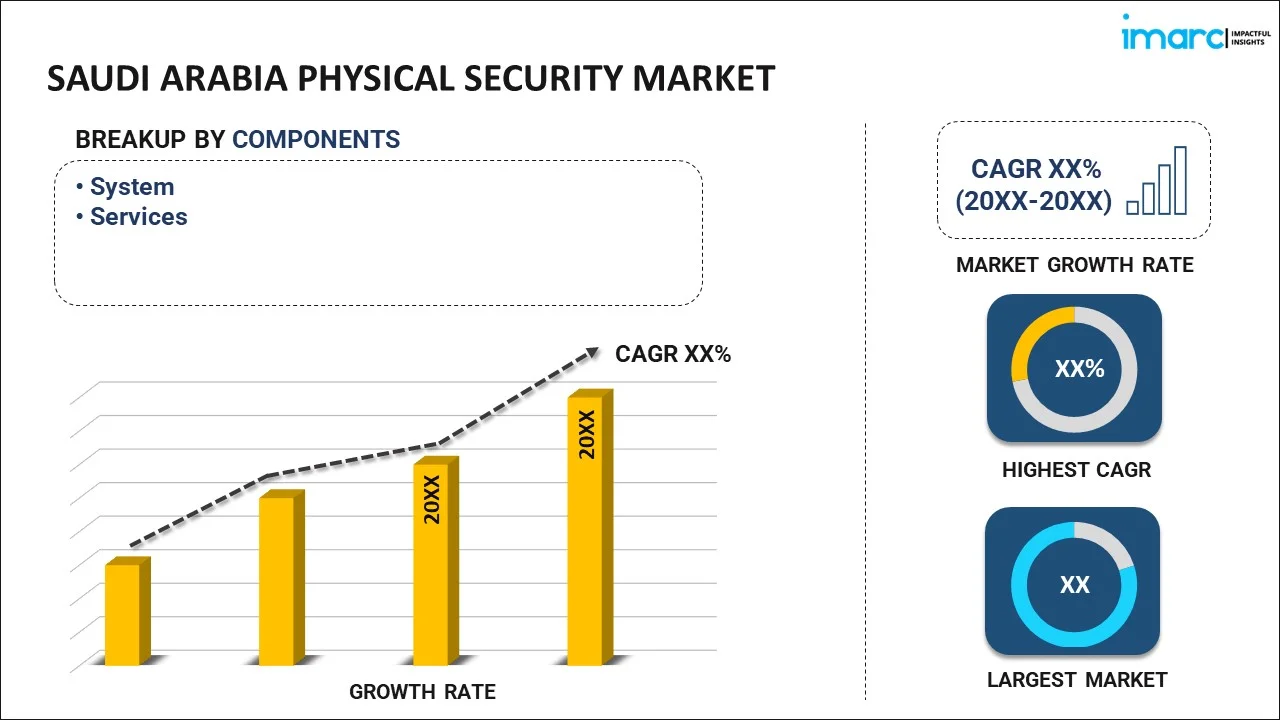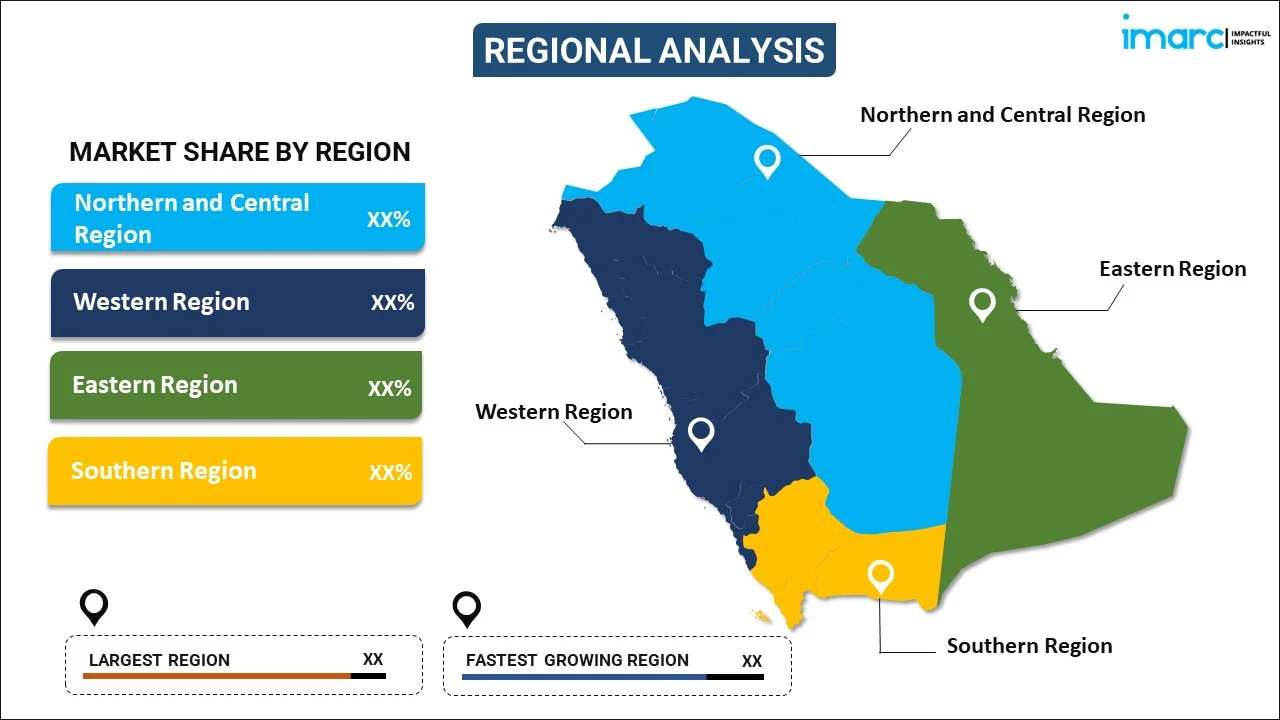
Saudi Arabia Physical Security Market Report by Component (System, Services), Enterprise Size (Large Enterprises, Small and Medium-sized Enterprises), Industry Vertical (Retail, Transportation, Residential, IT and Telecom, BFSI, Government, and Others), and Region 2024-2032
Market Overview:
Saudi Arabia physical security market size is projected to exhibit a growth rate (CAGR) of 8.10% during 2024-2032. The rapid advancements in technology, including video surveillance, access control systems, biometrics, and analytics, which enhance the effectiveness of physical security solutions, is driving the market.
|
Report Attribute
|
Key Statistics
|
|---|---|
|
Base Year
|
2023 |
|
Forecast Years
|
2024-2032
|
|
Historical Years
|
2018-2023
|
| Market Growth Rate (2024-2032) | 8.10% |
Physical security involves measures taken to protect physical assets, people, and information from unauthorized access, damage, theft, or harm. In various settings, such as buildings, facilities, and critical infrastructure, physical security employs strategies like access control, surveillance, and environmental design to deter or mitigate potential threats. This may include the use of security personnel, barriers, locks, alarms, and security systems. The goal is to create a secure environment that safeguards assets and ensures the safety of individuals within a defined space. Physical security considerations are vital for preventing unauthorized entry, detecting and responding to security incidents, and maintaining the integrity of physical assets. The integration of technology, personnel training, and procedural protocols contributes to a comprehensive physical security framework tailored to the specific needs and risks of a given environment.
Saudi Arabia Physical Security Market Trends:
The physical security market in Saudi Arabia is experiencing robust growth, driven by a confluence of factors. Firstly, the escalating threat landscape has propelled organizations across various sectors to prioritize the safeguarding of physical assets. Consequently, there is a growing demand for comprehensive security solutions that can effectively mitigate risks. Moreover, the increasing frequency and sophistication of cyber-physical attacks underscore the need for integrated physical security measures, creating a significant market driver. In addition to the rising security concerns, advancements in technology play a pivotal role in propelling the physical security market forward. The integration of cutting-edge technologies, such as artificial intelligence, video analytics, and facial recognition, enhances the efficacy of physical security systems. This technological evolution not only bolsters threat detection capabilities but also augments the overall efficiency of security infrastructure. Consequently, organizations are compelled to invest in modernizing their physical security frameworks, contributing to the expansion of the market. Furthermore, stringent regulatory requirements and compliance standards mandate organizations to implement robust physical security measures. The need to adhere to these regulations acts as a compelling force, driving businesses to adopt sophisticated security solutions to ensure compliance. This, in turn, is expected to drive the physical security market in Saudi Arabia during the forecast period.
Saudi Arabia Physical Security Market Segmentation:
IMARC Group provides an analysis of the key trends in each segment of the market, along with forecasts at the country level for 2024-2032. Our report has categorized the market based on component, enterprise size, and industry vertical.
Component Insights:

- System
- Physical Access System
- Video Surveillance System
- Perimeter Intrusion and Detection
- Physical Security Information Management
- Others
- Services
- System Integration
- Remote Monitoring
- Others
The report has provided a detailed breakup and analysis of the market based on the component. This includes system (physical access system, video surveillance system, perimeter intrusion and detection, physical security information management, and others) and services (system integration, remote monitoring, and others).
Enterprise Size Insights:
- Large Enterprises
- Small and Medium-sized Enterprises
A detailed breakup and analysis of the market based on the enterprise size have also been provided in the report. This includes large enterprises and small and medium-sized enterprises.
Industry Vertical Insights:
- Retail
- Transportation
- Residential
- IT and Telecom
- BFSI
- Government
- Others
The report has provided a detailed breakup and analysis of the market based on the industry vertical. This includes retail, transportation, residential, IT and telecom, BFSI, government, and others.
Regional Insights:

- Northern and Central Region
- Western Region
- Eastern Region
- Southern Region
The report has also provided a comprehensive analysis of all the major regional markets, which include Northern and Central Region, Western Region, Eastern Region, and Southern Region.
Competitive Landscape:
The market research report has also provided a comprehensive analysis of the competitive landscape. Competitive analysis such as market structure, key player positioning, top winning strategies, competitive dashboard, and company evaluation quadrant has been covered in the report. Also, detailed profiles of all major companies have been provided.
Saudi Arabia Physical Security Market Report Coverage:
| Report Features | Details |
|---|---|
| Base Year of the Analysis | 2023 |
| Historical Period | 2018-2023 |
| Forecast Period | 2024-2032 |
| Units | US$ Million |
| Scope of the Report | Exploration of Historical and Forecast Trends, Industry Catalysts and Challenges, Segment-Wise Historical and Predictive Market Assessment:
|
| Components Covered |
|
| Enterprise Sizes Covered | Large Enterprises, Small and Medium-sized Enterprises |
| Industry Verticals Covered | Retail, Transportation, Residential, IT and Telecom, BFSI, Government, Others |
| Regions Covered | Northern and Central Region, Western Region, Eastern Region, Southern Region |
| Customization Scope | 10% Free Customization |
| Report Price and Purchase Option | Single User License: US$ 3699 Five User License: US$ 4699 Corporate License: US$ 5699 |
| Post-Sale Analyst Support | 10-12 Weeks |
| Delivery Format | PDF and Excel through Email (We can also provide the editable version of the report in PPT/Word format on special request) |
Key Questions Answered in This Report:
- How has the Saudi Arabia physical security market performed so far and how will it perform size in the coming years?
- What has been the impact of COVID-19 on the Saudi Arabia physical security market?
- What is the breakup of the Saudi Arabia physical security market on the basis of component?
- What is the breakup of the Saudi Arabia physical security market on the basis of enterprise size?
- What is the breakup of the Saudi Arabia physical security market on the basis of industry vertical?
- What are the various stages in the value chain of the Saudi Arabia physical security market?
- What are the key driving factors and challenges in the Saudi Arabia physical security?
- What is the structure of the Saudi Arabia physical security market and who are the key players?
- What is the degree of competition in the Saudi Arabia physical security market?
Key Benefits for Stakeholders:
- IMARC’s industry report offers a comprehensive quantitative analysis of various market segments, historical and current market trends, market forecasts, and dynamics of the Saudi Arabia physical security market from 2018-2032.
- The research report provides the latest information on the market drivers, challenges, and opportunities in the Saudi Arabia physical security market.
- Porter's five forces analysis assist stakeholders in assessing the impact of new entrants, competitive rivalry, supplier power, buyer power, and the threat of substitution. It helps stakeholders to analyze the level of competition within the Saudi Arabia physical security industry and its attractiveness.
- Competitive landscape allows stakeholders to understand their competitive environment and provides an insight into the current positions of key players in the market.
Need more help?
- Speak to our experienced analysts for insights on the current market scenarios.
- Include additional segments and countries to customize the report as per your requirement.
- Gain an unparalleled competitive advantage in your domain by understanding how to utilize the report and positively impacting your operations and revenue.
- For further assistance, please connect with our analysts.
 Inquire Before Buying
Inquire Before Buying
 Speak to an Analyst
Speak to an Analyst
 Request Brochure
Request Brochure
 Request Customization
Request Customization




.webp)




.webp)












